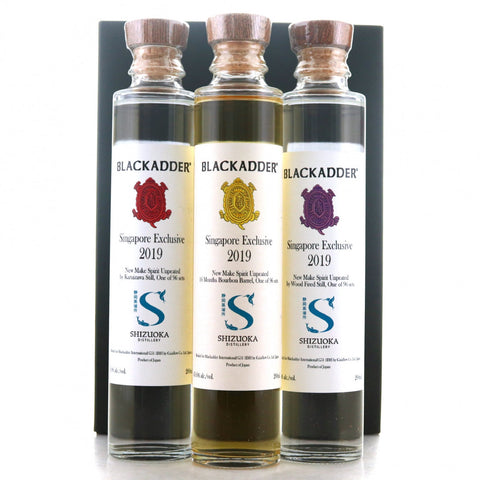Distillery Spotlight: Shizuoka Distillery
Region: Shizuoka City, Shizuoka Prefecture, Japan
Note: Our Distillery Spotlight articles discuss how each distillery's unique process results in the distinctive flavour profiles of their whisky. To find out more about each step of the whisky-making process, check out our Basics Series article on how to distil the elixir of life.

Shizuoka Distillery is nestled amidst the gorgeous Oku-Shizu mountains and pristine waters of the Abe River, the air is crisp; the whisky good. (Image Source: Shizuoka Distillery)

It’s not often that someone goes from generating renewable energy to making whisky; the two concepts seemingly sharing no similarities. But I suppose that’s what happens when you meet your heroes. Well that’s the story of Daiko Nakamura.

Almost a Ji-Whisky tradition, you can find Nakamura himself hosting tours around the distillery, just as many craft whisky distillery founders do.
Nakamura had started off his career in a family-run precision parts manufacturing business, and in a country known for lifelong employees, that comma could just as well have been a full-stop. But instead, a chance encounter with Ichiro Akuto, the man who revitalized Japanese craft whisky (or Ji-Whisky), of the renowned Chichibu Distillery, would set him on a journey to founding Nakamura’s own distillery, Shizuoka Distillery, in 2016.
This is the story of how Shizuoka Distillery came to be.

A field of solar panels sit under the watch of Mt Fuji. (Image Source: Energy Tracker Asia).
How Gaia Flow Went From Renewable Energy to Whisky Production
When Nakamura had encountered Ichiro, Nakamura’s company Gaia Flow was in the business of generating renewable energy – a burgeoning sector in Japan which is short on the clean stuff.
Yet the encounter with Ichiro and a trip to Scotland’s Islay distillery, Kilchoman, whose whiskies he loved, would inspire Nakamura to go into the whisky business. Kilchoman was a small distillery, relatively young, and known for producing amazing Single Farm Single Malt, using barley grown onsite.

At Kilchoman, everything is done by hand and sourced locally. (Image Source: Kilchoman Distillery)
You ever get that “Hey! I could do that!”-feeling? That’s exactly what struck Nakamura, who believed that like Kilchoman, he could be actively involved in every stage of the whiskymaking process and make great whisky.
Dipping his toes into the world of whiskies, Gaia Flow would first serve as an importer of whiskies, namely independently bottled whiskies such as Blackadder, Asta Morris and the Swedish whisky Mackmyra, into Japan. This would buy Nakamura time to put together the many pieces needed to start his own distillery.

The next four years would see Nakamura visit over 170 distilleries, breweries and wineries to learn the ins and outs of alcohol making. As if Nakamura could not get enough of fateful encounters, the location at which Shizuoka Distillery sits is itself a moment of serendipity.
Putting the Distillery Together
As Nakamura himself was from Shizuoka, he had of course hoped to base his passion project in his home prefecture, however, given its mountainous terrain and expensive usable land, this had seemed unlikely.
Yet, after several years of searching, he had found a suitable site in the Tamakawa area of Shizuoka. As fate would have it, the city official in-charge of determining the use of the land was himself a whisky fan and had desired for a distillery to be built on the land. Thus the two palms of fate came together, and Shizuoka Distillery had found a home.

Shizuoka's highly mountainous terrain meant there was little available usable land to build a distillery upon. (Image Source: His Go)
Being a Shizuoka native certainly helped as well, as he easily found support from fellow locals, including farmers who could provide him with local barley.
The distillery itself was designed to be simple yet modern, with its architecture crafted to allow visitors to simultaneously tour the distillery and also enjoy the breathtaking views of the natural Shizuoka mountains in the backdrop. This disallowed the surrounding green tea farms and beautiful forested mountains and its flora and fauna to go to waste.

Decked with locally harvested cedar and cypress, the distillery was designed to showcase its processes set against the Shizuoka landscape. (Image Source: Shizuoka Distillery)
As a malt maniac, Nakamura had a deep appreciation for the legacy he was to be a part of. This led him to famously take part in a public auction organized by the city of Miyota, where he was able to purchase the legendary mothballed Karuizawa Distillery’s equipment.
Despite most of the equipment being untenable, this was an obvious buy for Nakamura as the hammer price for the full set of equipment was a quarter of the value of the mill alone. Mills are deathly hard to come by and are exceptionally expensive as they are so well made that the companies making them have gone out of business in the 1970s.

The salvaged malt mill from Karuizawa dates back to 1939. Check out Whisky Stories for a fascinating story about why malt mills are so expensive.
The salvaged equipment has become a key part of Shizuoka Distillery, and Nakamura has even gone as far as to adopt the format of Karuizawa Distillery for his own distillery’s layout.
While much of the Karuizawa equipment was defunct, Nakamura was able to refurnish one of the four pot stills (which dates back to 1975), now affectionately named Still K, with a new heating system, as well as a Porteus malt mill (dated to 1939), which is used to process the raw barley. The remaining three pot stills have become part of the distillery’s decorations.

Still K refurbished and given a new lease of life at Shizuoka Distillery.
New and old, Nakamura has blended the both, as he joins the new wave of Japanese distilleries bringing back Ji-Whisky.
Bottling A Taste of Shizuoka
Thus far Shizuoka Distillery’s debut has been met with great excitement, with both Prologue K and Prologue W largely hitting it off with positive reviews.
The inaugural release, the Prologue K was distilled using the salvaged Karuizawa wash still and brought on key flavors like oiliness, minerality, lemons, peaches, crushed black pepper, slight spiciness of wasabi (Shizuoka is the birthplace of wasabi), and then a long clean, crisp finish.

You can take a more indepth look at our notes on the Prologue K here.
It was a 3 year old bottling and was compared to the likes of Springbank whisky and Caroni and Hampden rums; highly regarded names obviously, which is a great start to say the least.
Shortly thereafter, Prologue W followed. This time it featured the use of Shizuoka’s wood-fired directly heated pot still (one of the few distilleries using direct heating), nicknamed Still W, and incorporated more locally-sourced materials such as Shizuoka firewood and Japanese malt.

The Prologue W was mostly characterized by a more gentle scent, the consistent firm body, light smokiness and also a long, gentle finish.
You can read our notes on the Prologue W here.
As Nakamura puts it, his goal was to produce a “light, delicate spirit” that reflected the local environment to give fans a taste of what Shizuoka as a prefecture has to offer.
“We aim to make whiskey that is rooted in the local climate of Shizuoka and is in harmony with nature.”
Embodying Ji-Whisky Spirit with Local Shizuoka Elements
A core tenet of Ji-whisky, or Japanese craft whisky, is the use of local resources to allow the whisky to truly reflect its locality through its unique taste.

In true Ji-Whisky spirit, Nakamura has continuously sought to incorporate the use of local materials, with both releases using some amount of Japanese malt. This is itself a difficult feat given that Japan does not natively grow a significant amount of barley and most whiskies made in Japan rely on foreign imported barley (where Shizuoka Distillery gets its peated malt, its unpeated malt is sourced locally).

Shizuoka Distillery sits by the side of Abe River, where it sources the water in its whiskies from.
As whiskies are almost 50% water, it would make sense that the water used would have a deep influence on its taste and texture. Shizuoka Distillery has the benefit of being located on the banks of the Abe Nakagawachi River, which supplies moderately soft water for the distillery’s whiskies – landing at 69ppm, between Chichibu’s slightly harder water and Yamazaki’s slightly softer water.

The distillery also uses local firewood for heating of its stills, in particular Still W, and even its washbacks are made of local cedar wood. Currently, it is the only distillery in the world to use firewood to heat its stills.
The distillery’s interiors are beautifully furnished with plenty of Shizuoka-grown Sugi and Hinoki, or Japanese cedar and cypress respectively, designed by architect Derek Baston, who himself is a resident of Shizuoka.

Shizuoka Distillery's beautiful tasting room is furnished with local cypress wood.
Sitting at a fairly low altitude of 200m above sea level, the local climate is temperate and fairly seasonal in its weather, ranging from mild, sunny winters to hot, humid and rainy summers. It is windy yet snow remains rarely seen.
Fun Fact: Shizuoka is actually the rain-iest city in Japan.
Yet given its mountainous hideout, the temperature around the distillery is always 2-3 degrees lower than in the city, which is around 20 degrees Celsius.
It will be interesting to see how the local climate plays out in Shizuoka's whiskies.
Let's make whiskey like Shizuoka.
This is the vision of the Shizuoka Distillery.
As a Japanese whiskey born and nurtured by the blessings of nature in Shizuoka, I dream of being loved not only in Japan but all over the world, and I am working tirelessly to produce new whisky everyday.
And I hope that people who tasted the whiskey will visit the Shizuoka Distillery and feel their attachment to the land of Shizuoka.
- Daiko Nakamura, Founder of Shizuoka Distillery

Our Take
Shizuoka Distillery’s remarkable story has certainly inspired a great deal of excitement for the distillery’s whiskies. The idea of local makes is always going to be something special; not entirely different from how a big part of why we enjoy travelling so much is that we yearn to experience what the place uniquely has to offer and even bring some of it back.

Friendly distillery staff Mika Nakamura showing visitors the Sugi washbacks fermenting the barley malt.
The distillery’s heartening use of local barley, firewood, Sugi and Hinoki, the new lease on life for the legendary Karuizawa Distillery’s salvaged stills, are all special to the distillery.
The ability to capture what Shizuoka has to offer in a bottle is simply incredible, and rightly so – its first two bottlings have been wonderful to say the least. Highly robust, smooth with a great texture, a taste that is complex and multi-dimensional; it bears much potential.

Shizuoka is famous for its mikan or Japanese Mandarin Oranges. (Image Source: Old Tokyo)
If this is just the prologue, one is left beaming optimistically at what the main body might hold. Could we begin to see the distillery weave in influences of matcha or mikan (Japanese Mandarin Oranges) - Shizuoka's regional specialties?
Unfortunately, to put it bluntly, the Prologues K and W are incredibly difficult to access as demand for them have been overwhelming.

A set of Shizuoka Distillery's new makes. (Image Source: Whisky Auctioneer)
Yet all hope is not lost; prior to its inaugural releases, Shizuoka Distillery released several sets of its new makes in 200ml vials. The set contains (1) New Make Spirit Unpeated by Karuizawa Still, 63.5% ABV, (2) New Make Spirit Unpeated by Wood Fired Still, 63.3% ABV, and (3) New Make Spirit Peated 25 Months Manzanilla Sherry Cask, 61.4% ABV.
These new make sets are certainly not cheap but they are at least accessible and can still be found floating around the net.

Private bottlings like these are an alternative way to get your hands on Shizuoka Distillery's whiskies if you can't get your hands on the Prologue releases. (Image Source: Whisky Auctioneer)
If new makes are too young for you (they are very high in ABV and hence can be difficult to appreciate if not purely to satisfy your curiosity about the distillery), Shizuoka Distillery had and continues to periodically offer private cask programs, some of which have come to maturity and have been bottled for its owners, which can be found on auction sites as well. They can be identified by a separate label of their own.

Or if you can wait between 3-4 years, why not sign up for an entire private cask of your own! It’ll almost certainly be worth way more when you finally get it.
If you do decide to traverse down that path, save us a dram, we’ll be indefinitely grateful.
Kanpai!

@111hotpot
Big credits to the following sources, check them out for more on Shizuoka Distillery and much more:






